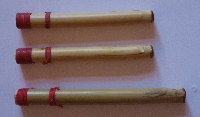What determines the pitch and sound of the drones?
For most of my bagpiping journey, I never thought much about the sound produced by the drones. At first, it seemed to me that the only question was whether the pitch was a perfect octave (or two) below the low-A on the chanter and that the only factor controlling this was the overall length of the drone. I never asked why the bass drone reed needs to be longer and fatter than the tenors. It seems to me now that the larger bass drone reed does contribute in some way to the lower pitch of the bass drone. It is not just a matter of the overall length. But it may be more about sound quality (the overtones that are produced in addition to the fundamental frequency). Another aspect that I only thought about very recently is the bore of the drones. Having just measured the bore as accurately as I can, here is what I found:
Bore Diameter (mm)
| Drone | Top Joint | Middle | Bottom | Reed seat |
| Bass | 15.0 | 9.2 | 8.5 | 10.2 |
| Tenor | 14.8 | 7.9 | 9.8 |
So you can see that the bore widens with distance from the reed, somewhat similarly to brass instruments such as the bugle or the trombone. When one considers the various shapes, sizes and materials of the different drone reeds that are now available, it is to be expected that they will affect the quality of the sound (as well as the pitch) produced by the drone. I was surprised to learn (quite recently) that the bag also contributes very significantly to the sound of the drones. When I started learning to play the oboe a few years ago, I discovered that the internal shape of the mouth cavity (and not just the pressure of the lips on the blades of the reed) can affect the resulting tone and pitch. In the case of the bagpipes, I now understand that the material of the bag makes a big difference to the overall sound, especially of the drones. The top pipers seem to prefer sheepskin to the synthetic bag which I have been using for the past decade or two. But with memories of the messy business of seasoning sheepskin and hide bags, I am not tempted.
Once the drone reed has been set (by adjusting the position of the bridle and the tuning screw, if there is one, and then firmly located in the end of the drone) there are only four variables that influence the subsequent sound. These are (a) pressure, (b) drone length, (c) temperature and (d) moisture.
Adjusting Ezeedrone Reeds
The first set of plastic drone reeds which I bought
In recent years, I have used only Ezeedrone reeds so I cannot talk about other maker's reeds.
There are two adjustments which affect the striking-in characteristics and pitch of the drone.
Cane
Until the advent of plastic drone reeds (I bought my first set from the College of Piping in 1987) the only type of drone reed was the traditional type made of cane, a very natural product, with one end closed using a blob of sealing wax and the other shaped to receive some hemp and then be inserted into the drone stock. The vibrating tongue was formed by cutting into the cane and then splitting it lengthways. The effective length of the vibrating tongue length was limited by a simple hemp bridle.
So for the first half of my bagpiping journey, I used only cane drone reeds. To my great surprise, you can still buy them from some bagpipe suppliers today. For instance Begg Bagpipes will sell you a set for £18+VAT (about a third of the price of the various plastic-bodied reeds. As Begg says on its website about the cane reeds, "sweet tone - bit of work to adjust initially but worth the effort". Based on my earlier experience, it is not an effort that I wish to expend!



